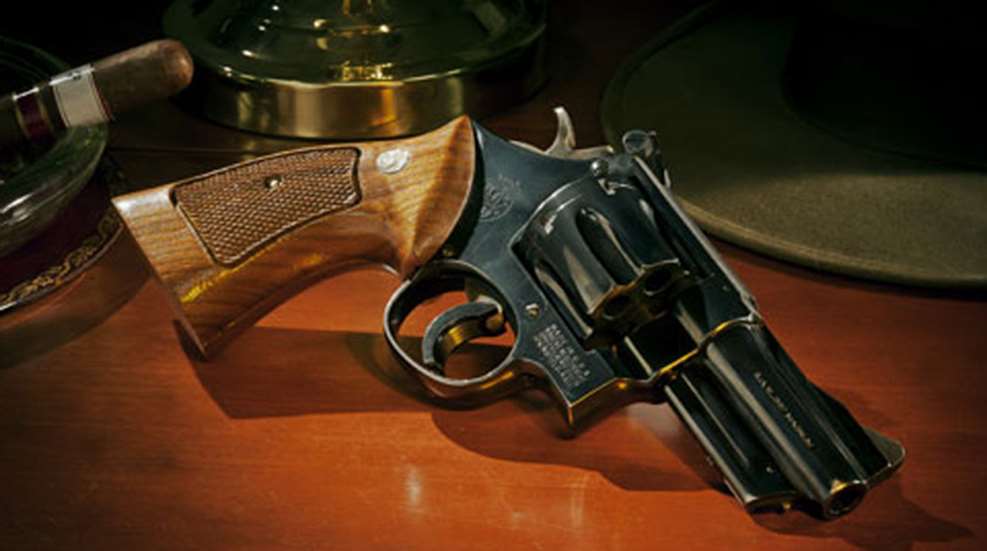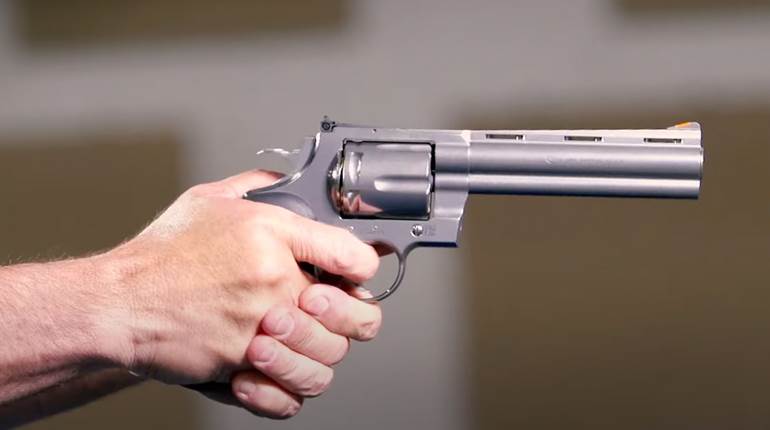
The 1920s was a fascinating time in American history. With the passage of the 18th Amendment enacting Prohibition, the United States allegedly became dry. In reality, though, Americans' insatiable thirst for demon rum provided a perfect environment for the underground enterprise of bootlegging. As with most criminal enterprises, profits were proportional to risks, and when the big money was at stake bullets tended to fly, and fly often. Too, just as today with big drug cartels, the big money bought lots of big, powerful guns. Law enforcement was caught behind the curve with their handy little .32- and .38-caliber double-action revolvers. Cops on the street pined for a revolver that had better penetration.
Smith & Wesson realized that if it loaded the .38 Spl. much hotter, it would overstress the relatively light frame of its .38 Military & Police revolvers, so the company chambered its heavy .44 frame in .38 Spl. with a 5-inch barrel, calling it the .38/44 Heavy Duty. Introduced on April 1, 1930, the .38/44, along with ammunition loaded to give a 158-grain bullet about 300 fps more velocity than a standard .38 Spl., the .38/44 was an instant success with policemen and rural troopers. About a year and a half later an adjustable-sight, 6 1/2-inch barreled version debuted as the .38/44 Outdoorsman, catering toward the hunter and long-range handgunner.
Phil Sharpe, a noted gun writer of the time and a member of the NRA Technical Staff, felt the .38/44 was capable of much better performance—read: higher velocity. Elmer Keith thought so as well, and both men separately began working up hotter loads that approached 1,400 fps with a 158-grain bullet. Keith's interest in the .38 caliber waned as he turned his attention to revving up the performance of the .44 Spl., but Sharpe continued stumping for a truly hot performing .38. He found a sympathetic ear in Smith & Wesson's Vice President Douglass B. Wesson. Smith & Wesson and the ammunition division of Winchester Repeating Arms took note, and by 1934 the cartridge design had been completed. It featured a .125-inch longer case than the .38 Spl. and launched a 158-grain bullet at 1,515 fps from an 8 3/4-inch barrel. A year later, Smith & Wesson introduced the revolver to contain this new mighty beast—the .357 Mag., which is reaching its 75th anniversary.
The brass at Smith & Wesson envisioned the .357 Mag. as a custom-built revolver, targeting handgun connoisseurs. America was deep in the bowels of The Great Depression, so the company could not fathom big sales of a revolver costing a mind-boggling $60-$15 more than any premium gun in the Smith & Wesson line. Each of the initial .357 Mag. revolvers was lavishly finished in a brightly polished blue. Any barrel length from 3 1/2 to 8 3/4 inches could be ordered. Chambers were burnished, and, of course, target sights were standard with a choice of seven front sights. The topstrap and barrel rib were hand checkered to eliminate any glare. Magna grips-with or without a grip adapter-were available. Each revolver was sighted in at the factory with the customers' choice of ammo at any distance out to 200 meters. The owner also received a numbered registration certificate in his or her name with all the features of the revolver. That registration number was stamped in the yoke cutout of the frame. FBI director J. Edgar Hoover received the first .357 Mag. on April 8, 1935. By the way, that $60 revolver of 1935 will fetch between $2,000 and $4,000 or more today.
Sales of the new .357 Mag. started very strong and continuously increased. The factory found it challenging to produce 120 guns a month, and even at that production could not keep up with demand. Smith & Wesson discontinued the registered Magnum idea in 1938 after some 5,500 revolvers. Production of the .357 Mag. ceased in 1941 in order to accommodate the wartime effort. Pre-war production of the .357 Mag. was 6,642 units.
Production resumed in 1948, and the action had been updated with the rebound-slide-operated hammer block and the short-throw hammer. Sales of the premium revolver remained very strong. In 1957 Smith & Wesson instituted its now-famous model numbering system, and the .357 Magnum became known as the Model 27. Three years later, the extractor rod was changed from a right-hand thread to a left-hand thread to correct the problem of the rod backing out during use and tying up the revolver. That change initiated the stamping of -1 after the model number. In 1962, the screw-retained plunger spring hole in the front of the trigger guard was eliminated, marking a second engineering change and a -2 after the model number. The Model 27 was given the full factory treatment of a target hammer, target trigger, oversized checkered Goncalvo alves target stocks and a mahogany presentation case in 1975-the year I bought my first centerfire revolver, a Model 27.
It came to me with an 8 3/8-inch barrel (Smith & Wesson trimmed 3/8 inch from its original 8 3/4-inch barrel years before to accommodate target shooters' rules regarding overall length). It shot wonderfully and was an easy gun to learn handgun shooting, but the long barrel made it ungainly to carry. At this period of time any Smith & Wesson premium revolver was a difficult item to come by, due primarily to the "Dirty Harry" phenomenon of the day. Trading it was out of the question since I would have to come up with more cash, and I had blown everything I had on the big gun already. All of my spare cash at the time went for handloading components. So I did the unthinkable: I had the barrel cut to 5 inches. Thankfully, this is one time I decided to not do the work myself, and a southern California gunsmith did the job.
Armed now with a real belt gun, I immersed myself into learning handgun marksmanship. For a little more than two years I would feverishly load 500 to 700 rounds of .38 Spl. wadcutters during the evenings on a single-stage RockChucker press and expend them all during a day or two of practice in the canyons outside Los Angeles. Meanwhile, my Model 27 traveled with me on numerous camping, hunting and backpacking trips. During this time I was buying guns-rifles, handguns and shotguns-with every bit of folding green I could spare from room, board and ammo requirements, but the Model 27 and later a Colt 1911 garnered the majority of my shooting attention.
By the time I first moved to Wyoming in 1979, I had, in addition to the Model 27 and 1911, a Colt New Frontier .22 LR/22 WMR, a custom-built .44 Spl. and a Model 29. The .44s were real man's guns-or so I thought at the time-and I relegated the .357 Mag. to varmint status. I had been shooting a lot and thought I was pretty hot, and maybe I was within the very small circle of gunnies I ran with at the time. On one occasion we were bounding along some dirt road deep within the forest when a rockchuck suddenly darted across the road going for a rock pile. I bailed out of the truck drawing the Model 27 from my Don Hume Jordan holster. I tracked the rodent as it scampered through the rocks; it leapt from one rock as I loosed a shot and center-punched the unlucky whistle-pig in mid air, some 30 yards away. Sometime later, a friend was visiting, and we retired to an area for some informal shooting. Once again, I was a bit full of myself and began to play Ed McGivern with the Model 27, holding it upside down and picking off cans double action with my pinkie finger. My buddy Gene said something like, "Smart alec," or thereabouts, and picked up a stick about 12 inches long and a couple inches in diameter, and threw it in the air. To be honest, I'm not sure who was the most surprised when the stick split in two in the air, but I tried to keep my game face intact as if it was just another shot. Of course, I declined the opportunity to repeat the feat, citing low ammunition supplies or some other desperate travesty.
As I look back at my 35-year marriage to my Model 27, I am somewhat embarrassed to admit no big-game experience with it. I have taken a pile of small game and varmints with it but nothing larger than a snowshoe hare. It has been, and remains my go-to double-action revolver to develop and maintain basic shooting skills. It has had more than 50,000 chunks of lead forced down its bore; been rebuilt twice (the last time I was told I'd need a new cylinder if I shot it loose again); and suffered several of my home-brewed gunsmithing indignities. Nonetheless, I still love her as much as the first day we met.
Like every great idea, the Model 27 has spawned several great progenies, the first being the Model 28 Highway Patrolman. Inspired by requests from state agencies like the Texas Highway Patrol for a revolver as sturdy as the .357 Mag. but without the costly enhancements, the Highway Patrolman is identical to its dandy-like brother but without the high polish and hand checkering of topstrap and barrel rib. First manufactured in 1954, the Highway Patrolman became a catalog item in 1955 with either a 4- or 6-inch barrel.
Though not of the same frame, the Model 19 traces its cartridge development directly to its big brother. Law enforcement officers started asking for a sidearm that didn't drag their pants down so much. Advances in metallurgy had even driven the .357 Mag. into the J-frame series of revolvers as light as 11 ounces, compared to the original 46 ounces for the N-frame gun.
Change is inevitable, and market demands have relegated the Model 27 to limited-run status. Now available in the Classic series in barrel lengths of 4 and 6 1/2 inches, in blue or nickel in the 4-inch barrel, the Model 27 remains one of the greatest revolvers ever produced. A modernized version, the Model 627, a stainless steel, eight-shot revolver is part of the Champion series. Smith & Wesson's Performance Center produces custom versions of the Model 627 featuring 2 5/8- and V-Comp 5-inch barrels.
There are lighter .357 Mag. revolvers to pack and more powerful, finely made revolvers to hunt with, but in my opinion there will always be a place for an accurate, premium-built revolver with the power of the .357 Mag. It's well behaved, beautiful and a joy to shoot. I can't imagine being without mine.






































